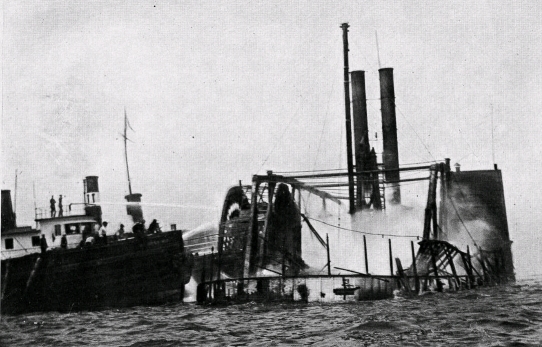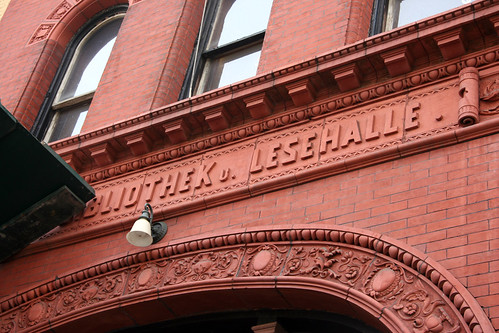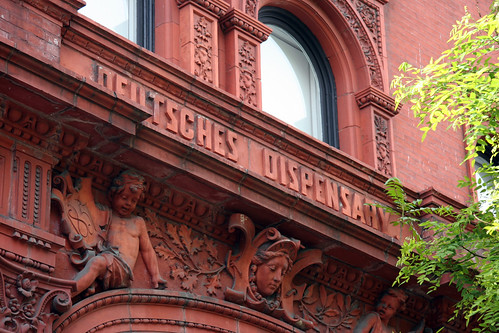If you live in New York, you’ve probably passed by these two beautiful buildings on 2nd Ave at 9th Street in the East Village a zillion times. On the left is a branch of the New York Public Library; on the right is a former medical clinic. What comes as complete surprise to me is that these buildings contain rare clues to the fact that this section of the city was once known as Little Germany.
At the turn of the century, there were approximately 50,000 German immigrants living in the area surrounding of Tompkins Square Park, which was then known as Kleindeutschland, or Little Germany (now referred to as Alphabet City). German schools, libraries, beer halls and shooting clubs served the cultural needs of a community permanently displaced from their homeland.
Then, in 1904, a disaster struck that would play a significant role in the demise of the neighborhood: The General Slocum Tragedy. A steamboat, the SS General Slocum, had been chartered by a local church to carry 1,300 residents of the neighborhood to its annual picnic in Long Island. Shortly after departing, the boat caught on fire. Passengers found no hope for salvation on board: life boats were painted to the floor, while ragged fire hoses burst apart on use. Mothers put their children in rotting life preservers and threw them overboard, only to watch in horror as they drowned. Few passengers, if any, knew how to swim.
1,021 people died in the tragedy (most of the passengers were women or children). Many socially prominent people were lost, and in the trauma and arguments over restitution payouts that ensued, most of the immigrants began moving uptown, eventually leading to the demise of Little Germany.
I relate this in order to better convey how amazed I am that clues to the existence of this defunct community are still around for those who know to look for them. If you look above the public library building, you see this written:
“Bibliothek u. Lesehalle,” or Free Library and Reading Room. If you look above the health clinic, you’ll see:
“Deutsches Dispensary.” The two institutions were first established by Anna Ottendorfer, a German language newspaper publisher and philanthropist, with the intention of “uplifting both the body and mind of fellow Germans in the United States” – in other words, to aid German immigrants in the transition to their new home in New York City with both health care and knowledge.
The library was the first to be erected in New York specifically as a free public lending library; it is now owned by the New York Public Library. The Dispensary offered continuous health care to the community for over 120 years until 2005, when it was acquired by developers with the intention of selling it to “a rock star like Lenny Kravitz” looking for an “eco-friendly” living environment and interested in installing an “indoor/outdoor saltwater swimming pool exiting to his gigantic organic garden.” (??? No joke). The idea apparently fizzled, as they are now looking to use the property for a “think tank” type of group. Current architect David Mayerfeld is actively working to restore the interior, stripping paint to reveal original finishes and removing newer drop ceilings.
More on the buildings: NY Times Streetscapes
Forgotten NY: General Slocum Disaster
Curbed: Interior Pics of the Dispensary
-SCOUT






Oh, nice, these are two of my favorite buildings in the city! I eat at Veselka constantly, so I see them a lot, and am always showing them off to friends.
There are two buildings on the south side of St Mark’s Place (between 2nd and 3rd) that also have German inscriptions–I’m trying to find them in my Flickr set now. They must be part of the same settlement.
Thanks for the background on the Slocum tragedy; I’d heard it mentioned but never knew the details.
i lived in the apartment directly above the butcher shop (the two windows above “market”) for three years in the late 80s and often wondered about those inscriptions. the butcher (my landlord) illegally smoked his own meats (mmmm, kielbasa) and as a result we were not permitted to have cable lest “the man” find out about the bootleg smoker… smallest apartment i ever lived in…
I. Love. This. Site.
Love the photos, love the history lessons, and love the anecdotes shared by the commenters. It makes my visits to NYC a bit richer, too.
Thanks, Scout!
Thanks for the great disaster shot of the General Slocum — I hadn’t seen that. Living in Yorkville — né Germantown — I have always been aware of the disaster.
There’s a good book about the General Slocum disaster. It was the worst maritime disaster in US history, but overshadowed by the Titanic soon after. The story is horrifying from start to finish.
One small awful/funny bit in the book is that the NY Chief of Police ordered the foot cops not to use their batons on the anxious crowds desperately waiting to find out if their relatives are dead or injured. Compassionate policing, I guess.
After the Sept. 11 attacks, David Rakoff wrote/spoke about the Slocum disaster on This American Life.
http://www.thisamericanlife.org/Radio_Episode.aspx?sched=890
There is a plaque in Astoria Park along the East River memorializing the General Slocum Disaster. Such a horrible tragedy. The plaque is not far from a defunct bocce ball court – a remnant of that neighborhoods Italian population.
One thing to mention is that, though a common narrative, the Slocum disaster had little to do with the migration of Germans away from the district.
In reality, it was the massive influx of Yiddish speaking Jews from Eastern/Central Europe/Russia which altered the dynamics of the neighborhood.
Many German Jews at the time essentially looked down upon Yiddish speaking Jews and tried to squash the language and culture. By 1910, the new waves of European Jews greatly outnumbered those leftover from Kleindeutschland — at the staggering number of 400,000+ per square mile (in comparison, there are about 70,000 people per square mile residing on Manhattan Island today).
Over a period of a decade or two, Germans filtered out.
When I was a student at Cooper Union I signed up for the cheapest student health plans I could through the school. If I remember correctly, I was assigned to the former health clinic in this building. I have a distinct memory of arriving for my annual “womens exam” and being simultaneously fascinated and totally creeped out by the archaic by-gone-era state of the exam rooms, complete with dingy drop ceilings with florescent tubes, “hospital-blue” walls, period porceline tiling that had seen nearly a century of disinfectant, and original midcentury fixtures and furnishings. I only visited the practice that one time as the next year we had a longer list of providers to choose from, but this was around 2002, so it makes sense if they were in the process of closing at the time? I still shiver a little inside when I think of the monstrous steel stirrups on the end of that 50y/o exam table–lol!